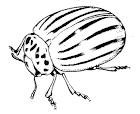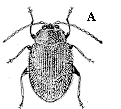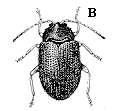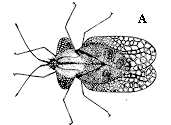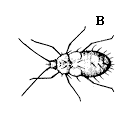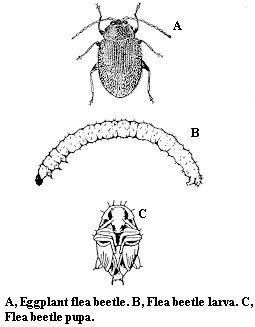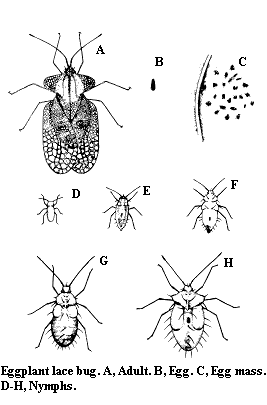Key to Eggplant Pests
Eggplant - a solanaceous crop - has some of the same pests as pepper, potato, and tomato. The eggplant flea beetle and the eggplant lace bug are common pests, but twospotted spider mites can be more damaging.
A. Chewing insects that feed on aboveground plant parts
- Beetles – Chewing insects with hard, shell-like forewings which meet in a straight line down the middle of the back; leave holes in foliage
- Colorado potato beetle – Yellowish-brown, oval, convex body 9 to 14 mm long; black spots on pronotum (area behind head); five black stripes on each wing cover (Figure 1); feeds on terminal buds and may consume entire leaves
- Flea beetles – Tiny, darkly colored, oval beetles with thickened, jumping hind legs; antennae 1⁄2 to 2⁄3 the length of the body; leave tiny "shot holes" in foliage
- Eggplant flea beetle – Black, slightly hairy body about 2 mm long with black legs (Figure 2A)
- Potato flea beetle – Brownish-black to black, body about 2.5 mm long; much less hairy than eggplant flea beetle (Figure 2B)
- Colorado potato beetle larva – Soft-bodied chewing insect up to 15 mm long; red, yellowish-red or orange body with black head, three pairs of black legs, and two rows black spots on each side of the body; one pair fleshy prolegs on last abdominal segment (Figure 3); chews holes in leaves and buds like adult beetle
B. Pests with needle-like mouthparts which feed on aboveground plant parts and extract plant juices
- Eggplant lace bug – Herds of grayish to light brown adults (Figure 4a) with spiny yellow nymphs (Figure 4b); adult 4 mm long, 2 mm wide with two pairs of lace-like wings and a hood-like projection just behind (or over) the head; feeds in colonies on underside of leaves; above, infested leaves have roughly circular discolored areas
- Twospotted spider mite – Tiny, almost microscopic, pale to dark green pest with 2 or 4 darkly colored spots; adult and nymph 8-legged; larva 6-legged; adult female, oval, 0.3 to 0.5 mm long; male more diamond shaped (Figure 5); feeds on undersides of leaves; infested foliage with silvery or pale yellow stipples, leaves eventually pale and dry up; silken webs common on undersides of leaves
C. Soft-bodied, root-feeding pests
- Flea beetle larvae – Several species of cylindrical, whitish larvae with brown heads, up to 4 to 5 mm long with 3 pairs of legs near the head and a pair of anal prolegs (Figure 6)
Eggplant Flea Beetle
Eggplant flea beetle, Epitrix fuscula Crotch, Chrysomelidae, COLEOPTERA
DESCRIPTION
Adult – The oval, black, 2 mm long beetle has thickened, jumping hind legs. Its antennae are 2⁄3 the length of its body. This species resembles the potato flea beetle but has black legs and slightly hairy wing covers.
Egg – Generally elliptical in shape, the egg is 0.4 mm long, 0.2 mm wide, and pointed at one end. Though white at first, it gradually becomes yellowish-gray.
Larva – A typical flea beetle larva is white with a brown head and three pairs of brown legs near its head. This species is 4 to 5 mm long when fully grown.
Pupa – Shaped roughly like adults, pupae are found in the soil. They are white at first but gradually darken.
BIOLOGY
Distribution – Occurring throughout most of this country, eggplant flea beetles tend to be most common in southern states.
Host Plants – This flea beetle has a narrow host range. Reports of its occurrence have been limited to eggplant, potato, horsenettle, pokeweed, sugar beet, and strawberry.
Damage – Feeding on new growth as it appears in spring, flea beetles can be very destructive to young plants. They leave foliage riddles with holes, the edges of which turn brown giving plants a diseased appearance. Though older leaves often withstand this injury, younger leaves may be killed. Flea beetle larvae feed on roots and may cause damage to tuber crops such as beet and potato.
Life History – Eggplant flea beetles overwinter as adults in soil or crop debris. Their life cycle has not been studied in North Carolina, but in Indiana they emerge from hibernation in mid- to late March. Weedy hosts such as horsenettle and pokeweed are infested until crop hosts become available. Eggs laid in soil near the bases of plants hatch in about one week. Larvae emerge from the eggs and feed on roots or tubers for 2 to 3 weeks. After developing through three instars, larvae pupate in the soil. The pupal stage lasts 7 to 10 days. Beetles emerge from the pupal skins, make their way out of the soil, and feed on leaves for 2 months or more. As a rule, flea beetles complete one to four generations each year. In North Carolina, there are probably three or four annual generations.
CONTROL
Cultural practices such as destruction of crop residue, weed control and late planting help minimize flea beetle problems. The removal of crop residue reduces the number of favorable overwintering sites for flea beetles. Covering plant beds and destroying trash around them also is beneficial. Control of weeds such as horsenettle and pokeweed around garden sites eliminates important early beetle food sources. Delayed planting favors the development of host plants over the establishment of flea beetles.
A number of insecticides (granular and foliar) are available to control adult flea beetles. For recommended chemicals and rates of application, consult the current North Carolina Agricultural Chemicals Manual.
Eggplant Lace Bug
Eggplant lace bug, Gargaphia solani Heidemann, Tingidae, HEMIPTERA
DESCRIPTION
Adult – The prothorax (area behind the head) of this gray and light brown bug has a hood-like projection which extends out over the body and comes to a point over the wings. The bug has a dark head, pale yellow legs, and two pairs of lace-like wings which are black at the base. The body appears flattened and is about 4 mm long and 2 mm wide.
Egg – The 0.4-mm-long, oval-elongate egg appears almost bottle-shaped. Greenish at the base and brown toward the tip, the egg has a crater-like depression in one end with a white, lace-like border. All eggs in each roughly circular cluster are deposited on end and lean in different directions.
Nymph – About 2 to 3 mm long, the mature nymph is yellow with a dark spot at the tip of the abdomen. The boy is covered with spines.
BIOLOGY
Distribution – Eggplant lace bugs are most common from Maryland, Missouri, and Oklahoma southward. They occur west into New Mexico and Arizona and have also been reported in New Jersey, Pennsylvania, Connecticut, and British Columbia.
Host Plants – The eggplant lace bug has a narrow host range. Its food plants include eggplant, tomato, potato, sunflower, sage, cotton, and horsenettle.
Damage – Circular discolored areas about the size of a quarter are the first noticeable symptoms of lace bug damage. The remains of an egg mass and a group of nymphs typically are found on the underside of each discolored spot. Lace bugs gradually move outward until the whole leaf yellows and dries out. Feeding in groups, they move from leaf to leaf and eventually to new plants. A severe lace bug infestation may kill whole plants or weaken them to the point that fruit fails to develop.
Life History – Eggplant lace bugs overwinter as adults within shriveled leaves or among other plant debris. They emerge and lay eggs in mid- to late May. Each female spends 4 to 5 days depositing 100 to 200 eggs in a roughly circular mass on the underside of a leaf. The female guards her eggs against predators. When the eggs hatch about 6 days later, the female continues to guard her offspring. Nymphs feed and move as a colony, guided by the adult female. Molting every other day, nymphs develop through five instars and become adults in about 10 days. Several days may elapse before adults of the new generation mate and deposit more eggs. Approximately 6 annual generations occur on eggplant followed by one or two additional generations on horsenettle.
CONTROL
Eggplant lace bugs are preyed upon by lady beetle larvae and adults, spiders, and shield-shaped soldier bugs. If lace bugs do become a problem, effective insecticides are available. For up-to-date recommendations, consult the current North Carolina Agricultural Chemicals Manual.
Publication date: Feb. 10, 2003
AG-295
Other Publications in Insect and Related Pests of Vegetables
N.C. Cooperative Extension prohibits discrimination and harassment regardless of age, color, disability, family and marital status, gender identity, national origin, political beliefs, race, religion, sex (including pregnancy), sexual orientation and veteran status.

